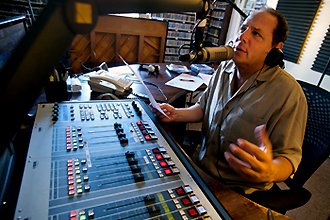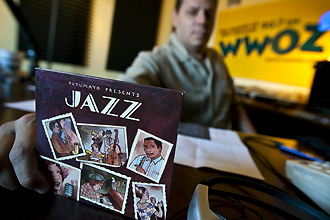Jazz CD Tells a Story
Joel Dinerstein grew up reading liner notes on records. That's how he started his education on musical forms from the blues to rock 'n' roll to jazz. This was before there were a lot of great jazz and blues books, says Dinerstein, a disc jockey at WWOZ radio in New Orleans, music critic and jazz scholar.

Joel Dinerstein, associate professor of English, has a regular gig as a disc jockey at WWOZ-FM. (Photos by Paula Burch-Celentano)
In his day job, Dinerstein is an associate professor of English and director of American studies at Tulane. He has now gone on to write his own book on the cultural history of Big Band swing music, Swinging the Machine: Modernity, Technology, and African American Culture Between the World Wars (University of Massachusetts Press, 2003). And he has written liner notes for a CD released this May Putumayo Presents Jazz.
“The intro [to Putumayo Presents Jazz] is what I think about jazz,” says Dinerstein. He uses the term “ensemble individuality” to describe the art form of jazz. By this, he means that each jazz musician has to develop a unique, identifiable voice. At the same time, a jazz artist has to contribute to the band, “sustain the groove,” he says.

Dinerstein wrote the liner notes and served as a music consultant for a new jazz CD produced by Putumayo World Music.
Jazz is all about collaboration. What jazz musicians do is they “have a conversation,” says Dinerstein.
He helped pick most of the tunes on Putumayo Presents Jazz, working in close collaboration with Putumayo founder Don Shorper. Putumayo is an international record company known for presenting music from around the globe.
Most of the cuts on Putumayo Presents Jazz were recorded during the “golden age” of jazz, from 1956 to 1961.
And most of the selections feature vocalists, including jazz icons such as Billie Holiday and Nina Simone, among others. Dinerstein, though, says that his favorite track is “Waltz for Debby,” an instrumental piece featuring “Cannonball” Adderley with Bill Evans. “It's beautiful,” Dinerstein says.
The whole CD “is an immensely enjoyable and accessible record,” says Dinerstein. “It's a great jazz 101 record.”
